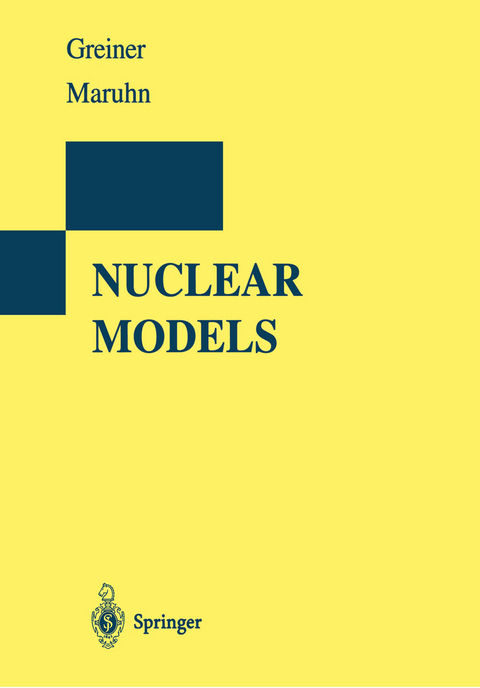
Nuclear Models
Springer Berlin (Verlag)
978-3-540-59180-1 (ISBN)
Prof. Dr. rer. nat. Dr. h. c. mult. Walter Greiner, geb. Oktober 1935 im Thüringer Wald, Promotion 1961 in Freiburg im Breisgau, 1962-64 Assistent Professor an der University of Maryland, seit 1964/65 ordentlicher Professor für Theoretische Physik der Johann Wolfgang Goethe-Universität Frankfurt am Main und Direktor des Instituts für Theoretische Physik. Gastprofessuren unter anderem an der Florida State University, University of Virginia, Los Alamos Scientific Laboratory, University of California Berkeley, Oak Ridge National Laboratory, University of Melbourne, Yale University, Vanderbilt University, University of Arizona. Hauptarbeitsgebiete sind die Struktur und Dynamik der elementaren Materie (Quarks, Gluonen, Mesonen, Baryonen, Atomkerne), Schwerionenphysik, Feldtheorie (Quantenelektrodynamik, Eichtheorie der schwachen Wechselwirkung, Quantenchromodynamik, Theorie der Gravitation), Atomphysik. 974 Empfänger des Max-Born-Preises und der Max-Born-Medaille des Institute of Physics (London) und der Deutsche Physikalische Gesellschaft, 1982 des Otto-Hahn-Preises der Stadt Frankfurt am Main, 1998 der Alexander von Humboldt-Medaille, 1999 Officier dans l'Ordre des Palmes Academiques. Inhaber zahlreicher Ehrendoktorwürden (unter anderem der University of Witwatersrand, Johannesburg, der Universite Louis Pasteur Strasbourg, der UNAM Mexico, der Universitäten Bucharest, Tel Aviv, Nantes, St. Petersburg, Moskau, Debrecen, Dubna und anderen) sowie Ehrenprofessuren (University of Bejing, China, und Jilin University Changchun, China) und Ehrenmitglied vieler Akademien.
1. Introduction.- 1.1 Nuclear Structure Physics.- 1.2 The Basic Equation.- 1.3 Microscopic versus Collective Models.- 1.4 The Role of Symmetries.- 2. Symmetries.- 2.1 General Remarks.- 2.2 Translation.- 2.3 Rotation.- 2.4 Isospin.- 2.5 Parity.- 2.6 Time Reversal.- 3. Second Quantization.- 3.1 General Formalism.- 3.2 Representation of Operators.- 3.3 Evaluation of Matrix Element for Fermions.- 3.4 The Particle-Hole Picture.- 4. Group Theory in Nuclear Physics.- 4.1 Lie Groups and Lie Algebras.- 4.2 Group Chains.- 4.3 Lie Algebras in Second Quantization.- 5. Electromagnetic Moments and Transitions.- 5.1 Introduction.- 5.2 The Quantized Electromagnetic Field.- 5.3 Radiation Fields of Good Angular Momentum.- 5.4 Coupling of Radiation and Matter.- 6. Collective Models.- 6.1 Nuclear Matter.- 6.2 Nuclear Surface Deformations.- 6.3 Surface Vibrations.- 6.4 Rotating Nuclei.- 6.5 The Rotation-Vibration Model.- 6.6 ?-Unstable Nuclei.- 6.7 More General Collective Models for Surface Vibrations.- 6.8 The Interacting Boson Model.- 6.9 Giant Resonances.- 7. Microscopic Models.- 7.1 The Nucleon-Nucleon Interaction.- 7.2 The Hartree-Fock Approximation.- 7.3 Phenomenological Single-Particle Models.- 7.4 The Relativistic Mean-Field Model.- 7.5 Pairing.- 8. Interplay of Collective and Single-Particle Motion.- 8.1 The Core-plus-Particle Models.- 8.2 Collective Vibrations in Microscopic Models.- 9. Large-Amplitude Collective Motion.- 9.1 Introduction.- 9.2 The Macroscopic-Microscopic Method.- 9.3 Mass Parameters and the Cranking Model.- 9.4 Time-Dependent Hartree-Fock.- 9.5 The Generator-Coordinate Method.- 9.6 High-Spin States.- Appendix: Some Formulas from Angular-Momentum Theory.- References.
| Erscheint lt. Verlag | 23.2.1996 |
|---|---|
| Vorwort | D.A. Bromley |
| Zusatzinfo | XVI, 376 p. |
| Verlagsort | Berlin |
| Sprache | englisch |
| Maße | 189 x 246 mm |
| Gewicht | 830 g |
| Themenwelt | Naturwissenschaften ► Physik / Astronomie ► Atom- / Kern- / Molekularphysik |
| Naturwissenschaften ► Physik / Astronomie ► Plasmaphysik | |
| Schlagworte | Element • Fission • HC/Physik, Astronomie/Atomphysik, Kernphysik • Kernmodell • Kernmodelle • Kernphysik • Kernphysik; Handbuch/Lehrbuch • Kernphysik; Hand-/Lehrbücher • Neutron • Nuclear model • nuclear models • nuclear physics • Nucleon • Particle physics • Quantum Chromodynamics • quantum electrodynamics • quantum mechanics • Radiation • scattering • Weak Interaction |
| ISBN-10 | 3-540-59180-X / 354059180X |
| ISBN-13 | 978-3-540-59180-1 / 9783540591801 |
| Zustand | Neuware |
| Informationen gemäß Produktsicherheitsverordnung (GPSR) | |
| Haben Sie eine Frage zum Produkt? |
aus dem Bereich


